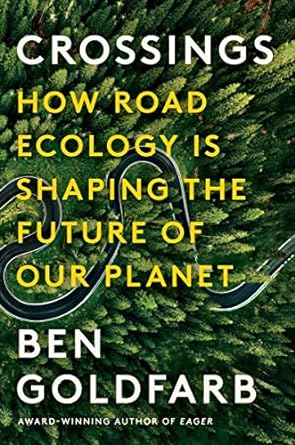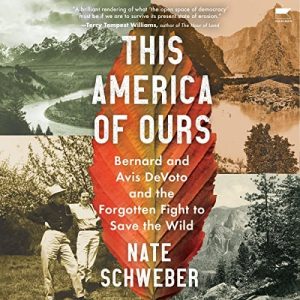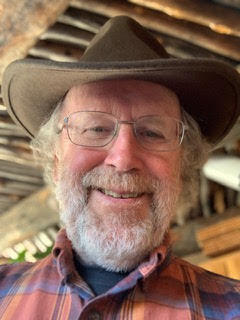Crossings: How Road Ecology is Shaping the Future of our Planet

Ben Goldfarb, Crossings: How Road Ecology is Shaping the Future of our Planet. New York: W.W. Norton & Company, 2023.
In the 1990s I served on the Washington Forest Practices Board for nearly a decade, and time after time I heard that Interstate 90 over Snoqualmie Pass was a serious barrier to wildlife dispersal and a danger to wildlife and drivers alike. The highway was due for an upgrade, and a campaign was launched to create crossings to alleviate the problems for wildlife moving north or south across the multilane highway bisecting excellent habitat for many species. Advocates were not optimistic because such a project would be very costly but, as Ben Goldfarb recounts as he closes this book, the crossing effort succeeded. “Conservationists campaigned for a modest gas tax hike to pay for crossings, among the only environmental campaigns ever to request more funding for construction. Soon the former foes [engineers and conservationists] were singing kumbaya, and engineers had designed more than twenty wildlife crossings in a fifteen mile stretch of highway.” The crossings are there — I saw them a few weeks ago when I drove over the pass.
Journalist Ben Goldfarb thus concludes this excellent book on a positive note, and readers will need some uplift after digesting the troubling stories Goldfarb tells. While he highlights some good news, the overall message I take from the book is that highways are a huge worldwide problem for wildlife. The costs and benefits are on balance positive for people, though highways, as he describes in several sections, take a considerable toll on humans as well. This book is about road ecology, a relatively new field that is revealing the interactions between roads and everything around them. It is full of sobering generalizations. “Roads, any engineer would tell you, ostensibly exist to serve society. In truth, it’s the other way around: once a road is built, our lives and landscapes bend to conform with it. Name an environmental problem, and it’s exacerbated by the access that roads provide and the incentives they create.” Or this one: “Roads so transmute our lives that one scholar has described Homo sapiens as an ‘infrastructure species’- an organism whose essential trait is that it is shaped by its own construction.” Or another: “The purpose of wildlife crossings is to create landscapes that are navigable by hoof or paw; the purpose of freeway obliteration is to allow people to walk through their communities. Road ecologists and urban advocates are engaged in the same project: creating a world that is amenable to feet.” Birds can fly over highways, but many species must walk or run. Highways like the interstate highway system in America bisect human communities and often preclude walking anywhere near them. Some are being changed (“obliterated”) in hopes of restoring human connectivity in bisected communities. Connectivity is essential for both human and wildlife communities.
These quotations reveal the scope of this remarkable book. It describes the toll roads are taking on wildlife through roadkill and barriers to movement across landscapes. It explains how road ecologists are working to mitigate these problems. The impacts roads are having on human communities and the work urban planners are doing to try and reduce these impacts are chronicled. Road ecology, writes Goldfarb, may be “loosely defined as the study of how ‘life change[s] for plants and animals with a road and traffic nearby.’” He details these changes, some obvious to most of us, some not, noting also that “Road ecology was an act of inter-species imagination, a field whose radical premise asserted that it was possible to perceive our built world through non-human eyes.” Or ears. An entire chapter is devoted to how road noise disrupts animal lives, the title of the chapter inspired by Walt Whitman’s observation in Song of Myself that a walk in New York “was to experience ‘the blab of the pave,’ including the ‘tires of carts’ and ‘the clank of shod horses.’” Goldfarb provides examples of the many ways road noise affects wildlife, even in national parks where roads have been designed and constructed so that visitors can enjoy, at considerable risk to wildlife, what one historian has called “windshield wilderness.”
On the other hand, in a chapter titled “Hotel California,” the plight of wildlife, and especially mountain lions, in greater Los Angeles is the focus. Some cats moved successfully across busy highways but then found themselves isolated on “islands,” in the Santa Monica mountains. Freeways marooned them, “cut off from the rest of cougar society by straits of traffic. And without immigrants to freshen it their gene pool had turned as stagnant as a roadside puddle.” Scientists monitored the state of the cats and isolated a location where an overpass might be constructed to allow cougars to move in and out. They concluded that one large structure at Liberty Canyon estimated to cost $87 million to build was the only feasible solution. One cougar identified as P-22, became a legendary LA media star, an “action hero, the roguish bachelor, the unrequited lover, admired for his pluck and pitied for is isolation.” A remarkable conservationist named Beth Pratt took on the huge task of raising the money for the Liberty Canyon Project, making herself the “self-appointed publicist and agent” of P-22, and ultimately organizing a campaign that raised the $87 million needed to the project, which was built.
Liberty Canyon, to Pratt’s mind, was both precedent-setting and sui generis. The overpass would be the culmination of decades of road-ecology art and science: if you could entice an apex carnivore over a California freeway, you could do anything. No other crossing would ever cost so much or require so much private funding. “When this is over,” Pratt added, “the idea is that I’m out of a job doing fundraising for wildlife crossings, and these become embedded in budgets.” She sounded, I thought, a little wistful.
As it turned out, Pratt had not worked herself out of a job but with her remarkable success she had worked herself into one leading the Wildlife Crossing Fund, “an effort to raise an astonishing half-billion dollars; at P-22’s memorial service, Wallis Annenberg, the philanthropist who had ponied up for the 101 overpass, announced she would chip in the first $10 million.”
Goldfarb traveled widely in the research for Crossings, visiting many sites across America that revealed different challenges and opportunities for road ecologists. His travels also took him to Costa Rica, Tasmania, Australia, and Brazil, and he interviewed road ecologists in many other places. Accounts of road impacts on wildlife include white-tailed deer in the eastern United States, herps, reptiles, and amphibians in many locales, salmon in the Pacific northwest, monarch butterflies in the upper Midwest, wombats and other marsupials in Tasmania, and giant anteaters in Brazil, among others. He spent years collecting examples of road-caused problems for wildlife, and some for people, searching for examples of how road ecologists were finding measures to counter the “tsunamis” of roadkill and other wildlife impacts.
He found that scientists and activists are coming up with some creative and remarkable solutions, measures like the crossings mentioned earlier. For instance, learning that remaining monarch butterfly habitat in the American Midwest fell along Interstate 35, nearly 1,600 miles from Duluth, Minnesota, to Laredo, Texas, Goldfarb reports that “a handful of midwestern states signed a memorandum to support the so-called Monarch Highway, an agreement to ‘protect, plant and manage pollinator habitats’ along the interstate.” This “Monarch Highway,” as he describes it, “inverted the concept of a road: it was a linear infrastructure whose users were wild, a road designed to support habitat rather than trash it. Although the interstate was the unifying thread, the Monarch Highway’s footprint stretched many miles wider, enfolding not only I-35 but the farms, backyards, and other lands around it.” While this was a “symbolic highway” it brought public attention to the plight of these migratory butterflies and measures to help them along their way.
Another example involved eagles, part of the “necrobiome” that feeds on roadkill and thus is vulnerable to becoming roadkill. A simple solution would be to “transform carcasses into cornucopias” by dragging deer carcasses forty feet from the highway so that eagles (and other roadkill scavengers) could “gorge themselves in peace.” The usual practice is to drag them off the highway onto the shoulder, exposing feeding birds to traffic. In another case, Washington State was mandated by the U.S. Supreme Court after extensive litigation to remove or reconstruct culverts causing all sorts of problems for salmon and other critters. Culverts would be removed or converted to allow passage under roads. Additionally, in some places roads are actually being removed, including parts of the 370,000-miles of the national forest road system. In Brazil where he describes a tsunami of roadkill, Goldfarb rides through Carolos Botelho State Park with a road ecologist on a highway that connects Sao Paulo to points west, a busy connector. The highway bisects the park which is closed between 8:00 p.m. and 6 a.m. when animals are most active. Additionally, this road was designed to slow traffic the rest of the time. “We were protected from speeding not only by law but by design. Practically every highway I’d ever driven on, I realized, was built to facilitate swift and seamless automobility. SP-139, by contrast, deliberately transgressed the conventional ideals of engineering, frustrating human users in service to animals.” Such measures as closing or designing roads to slow traffic for wildlife may be considered radical by many, but if they can be applied in Brazil, why not elsewhere?
Goldfarb is a very thoughtful student of crossings, whether they be locales for roadkill or measures to prevent it. Throughout this book he offers striking insights. For instance, anti-conservation forces fight for roads, “chiefly American Stewards of Liberty, a far-right group whose leaders insisted, against all evidence to the contrary, that 30X30 was a plot to trample property rights and cause ‘the destruction of our nation.’” Roads have become “cultural markers that distinguish warring factions.” Goldfarb observes that “Roadless areas are planetary buffers against extinction: a species that resides within a wilderness is more than twice as likely to survive as one in the hellscape beyond.” To this he added — and this struck me profoundly as an advocate of wilderness stung by critiques of wilderness — that “As an abstraction, wilderness is passé. But as a physical place — a landscape defined by roadlessness — it’s more vital than ever.”
He observes that like roads, culverts are symbols as well as structures. “In Washington each humble pipe carried the weight of colonialism, civil disobedience, and perseverance against deferred justice.” A challenge of climate change is that it is changing landscapes in a “cruel and ironic way,” making them “less permeable to wildlife at the precise moment animals need to move most.” And if we consider ourselves duty bound by our ethics to reduce pain, what does this require of us regarding roads and wildlife? What are our “positive obligations, the actions we should take on animals’ behalf?” Road ecology, he suggests, “is not merely a set of engineering principles but a moral mandate.”
Most of us constantly travel on roads hardly giving a thought to their impacts on wildlife and people until we hit a deer or see carnage lying on or beside our road. Roads are necessary for modern life, but are all roads equally necessary? Must we always drive faster as our vehicles enable us to do so? Crossings is a must-read for wildlife advocates and rewilders, and for anyone who asks, as I often do, “What’s the rush?” Adequately detailing the scope of Goldfarb’s reporting and reflection about the subject of this book in a brief review is impossible. I knew, as I looked at the wildlife crossings in Snoqualmie Pass, that progress was being made in thinking and acting on how to improve wildlife movement and connectivity in the face of barriers like roads, but I did not appreciate the scale of the problems and the fact that there is now a cadre of road ecologists hard at work. Nor was I aware of the creative thinking that is going into addressing these challenges, or the actual physical work on underpasses, overpasses, culverts, and road design that has been completed and is under way. I learned a great deal and enjoyed the way Goldfarb addressed such a difficult subject. As I drove home to Taos from Santa Fe after dark on a rural route last evening, I kept an eye peeled for deer, elk, or coyote, and slowed down. This book has raised my awareness and changed my behavior, and I already thought myself aware of the “crossings” problem.
Get your own copy of the book here: Crossings: How Road Ecology is Shaping the Future of our Planet.
David Brower, then Executive Director of the Sierra Club, gave a talk at Dartmouth College in 1965 on the threat of dams to Grand Canyon National Park. John, a New Hampshire native who had not yet been to the American West, was flabbergasted. “What Can I do?” he asked. Brower handed him a Sierra Club membership application, and he was hooked, his first big conservation issue being establishment of North Cascades National Park.
After grad school at the University of Oregon, John landed in Bellingham, Washington, a month before the park was created. At Western Washington University he was in on the founding of Huxley College of Environmental Studies, teaching environmental education, history, ethics and literature, ultimately serving as dean of the College.
He taught at Huxley for 44 years, climbing and hiking all over the West, especially in the North Cascades, for research and recreation. Author and editor of several books, including Wilderness in National Parks, John served on the board of the National Parks Conservation Association, the Washington Forest Practices Board, and helped found and build the North Cascades Institute.
Retired and now living near Taos, New Mexico, he continues to work for national parks, wilderness, and rewilding the earth.



I would like to see the evidence that wildlife actually uses the crossings, as opposed to still attempting to cross roads or seeing roads as barriers that can’t be crossed. I have no doubt that these wildlife crossings are used to some extent by wildlife, but it would be very helpful to know that extent.
Roads are very ecologically harmful for multiple reasons. These wildlife crossings are a big improvement, but they don’t fix the other problems, such as unnatural noise, pollution (including the climate crisis), destruction of ecosystems and killing of wildlife for extraction, etc. Let’s not fantasize that we can have our cake and eat it too, because we can’t. Roads and industrial society must eventually be eliminated.
Excellent review. As Goldfarb emphasizes, SCALE of time and space shapes perceptions and knowledge of our highways and byways. If you want to see how serious the problem is, ride a bicycle where “a road runs through it,” urban, rural, or wild. As a lifelong bicyclist, I’ve been witnessing the carnage for six decades and am appalled every time.